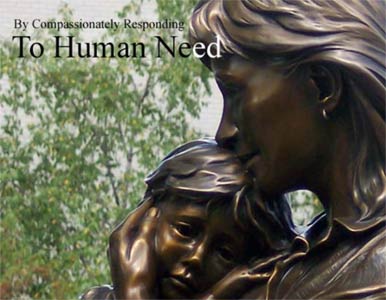
The Charity of St. Elizabeth of Hungary
by Edmund Blair Leighton (1853-1922)
St. Elizabeth of Hungary
St. Elizabeth is remembered for her charitable works, especially for the establishment of hospitals. Today, dozens of hospitals and medical centers are named for her, several of them founded by the Sisters of St. Francis. Elizabeth lived at a time when the combined disasters of climate, war, pestilence, and poverty caused great suffering, and she became devoted to helping those who had nowhere to turn.
Elizabeth was born in Hungary in 1207. Her short but fruitful life lasted 24 years; she passed away in Marburg, Germany on November 17, 1231. November 17 is the feast day of St. Elizabeth celebrated by the Church.
She began life as part of the Hungarian nobility, daughter of King Andrew II. At age 14, she married the 21-year-old Ludwig IV, of Thuringia (Germany). He was appointed regent of Meissen and the East Mark and who soon became employed by Holy Roman Emperor Frederick II as a soldier and diplomat.
Elizabeth was religious since her early years, and Ludwig supported her in this, including her acts of charity. While he was away for missions under Frederick II, Elizabeth took charge of local affairs and distributed alms in all parts of her husband's territory. A well-known painting depicts her personal involvement in charitable works (below).

To take care of those who were both sick and destitute, she had a small hospital built below the Wartburg castle, with twenty-eight beds. Her personal touch was evident there: she visited the patients daily to attend to their needs; at the same time she aided hundreds of poor people daily through giving food and other supplies.
Ludwig died on one of his military campaigns, succumbing to illness not war wounds. Their third child was born shortly after his death.
Elizabeth then became associated with the Franciscans. They established their first settlement in the region in 1221 and she obtained spiritual instruction from them. The ideals of St. Francis appealed to her: chastity, humility, patience, prayer, and charity. Because of her royal position, the vow of poverty that Franciscans took was not easy to pursue and her retention of funds made the charitable work she pursued more fruitful; over time she distributed everything she had. It was with her financial aid and spiritual support that the Franciscans in 1225 founded a monastery in Eisenach. Conrad of Marburg, who had been held in high esteem by Ludwig, became her spiritual advisor. It is said that he treated Elizabeth with all the severity of his nature, for which he had a considerable reputation, but through this led her to new levels of sanctity and charity; after her death he was very active in her canonization.
On Good Friday, 1228, in the Franciscan house at Eisenach, Elizabeth formally renounced the world; she received from Conrad the dress of the Third Order of St. Francis. In the summer of 1228 she built the Franciscan hospital at Marburg and on its completion devoted herself entirely to the care of the sick, especially to those afflicted with debilitating and disfiguring diseases.
Soon after the death of Elizabeth, miracles were reported to occur at her grave in the church associated with the hospital, especially miracles of healing. At Pentecost of the year 1235, the solemn ceremony of canonization of the "greatest woman of the German Middle Ages" was celebrated by Gregory IX at Perugia, with Conrad present.
Conrad had written in support of her canonization a letter, of which a portion is reproduced here:
Elizabeth was a lifelong friend of the poor and gave herself entirely to relieving the hungry. She ordered that one of her castles should be converted into a hospital in which she gathered many of the weak and feeble. She generously gave alms to all who were in need, not only in that place but in all the territories of her husband's empire. She spent all her own revenue from her husband's four principalities, and finally she sold her luxurious possessions and rich clothes for the sake of the poor.
Twice a day, in the morning and in the evening, Elizabeth went to visit the sick. She personally cared for those who were particularly repulsive; to some she gave food, to others clothing; some she carried on her own shoulders, and performed many other kindly services. Her husband, of happy memory, gladly approved of these charitable works. Finally, when her husband died, she sought the highest perfection; filled with tears, she implored me to let her beg for alms from door to door. Good Friday of that year, when the altars had been stripped, she laid her hands on the altar in a chapel in her own town, where she had established the Friars Minor, and before witnesses she voluntarily renounced all worldly display and everything that our Savior in the gospel advises us to abandon. Even then she saw that she could still be distracted by the cares and worldly glory which had surrounded her while her husband was alive. Against my will she followed me to Marburg. Here in the town she built a hospice where she gathered together the weak and the feeble. There she attended the most wretched and contemptible at her own table.
Apart from those active good works, I declare before God that I have seldom seen a more contemplative woman.
Before her death I heard her confession. When I asked what should be done about her goods and possessions, she replied that anything which seemed to be hers belonged to the poor. She asked me to distribute everything except one worn-out dress in which she wished to be buried. When all this had been decided, she received the body of our Lord. Afterward, until vespers, she spoke often of the holiest things she had heard in sermons. Then, she devoutly commended to God all who were sitting near her, and as if falling into a gentle sleep, she died.
In August of 1235, soon after her canonization, the corner-stone of the beautiful Gothic Franciscan church of St. Elizabeth was laid at Marburg. On May 1, 1236, Emperor Frederick II attended the taking-up of the body of the saint; in 1249 the remains were placed in the choir of the church of St. Elizabeth (see photo of church, below).

Almighty God, by whose grace your servant Elizabeth of Hungary recognized and honored Jesus in the poor of this world:
Grant that we, following her example, may with love and gladness serve those in any need or trouble.
In the name and for the sake of and through Jesus Christ our Lord, who lives and reigns with you and the Holy Spirit, one God, now and for ever. Amen

Detail of a statue representing St. Elizabeth at the Provena United Samaritans Medical Center, "a Catholic health system, that builds communities of healing and hope by compassionately responding to human need in the spirit of Jesus Christ." It has a 210-bed comprehensive medical center in Danville, Illinois, the development of the St. Elizabeth Hospital founded in 1882. The facility mainly serves patients in East Central Illinois and Western Indiana. The Medical Center has a medical staff of more than 100 physicians
.